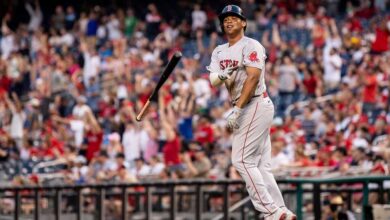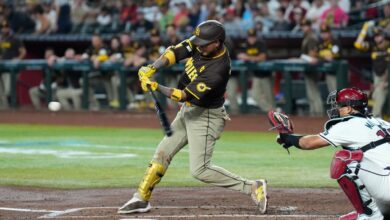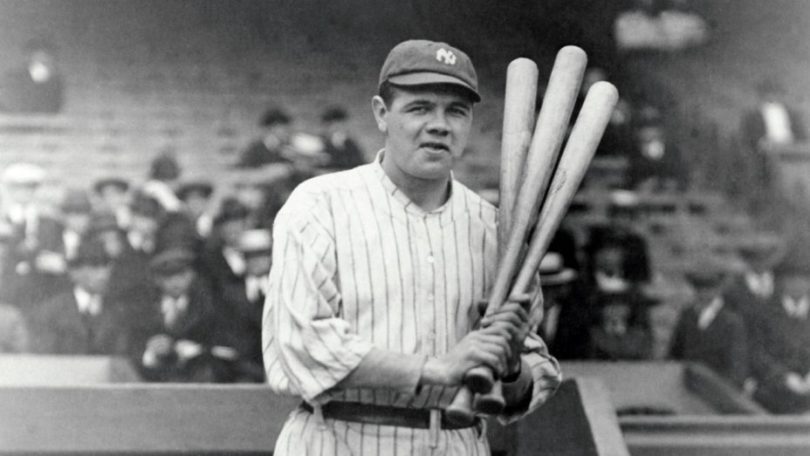
I was fortunate to work with Juan C. Rodriguez, the Florida Marlins beat reporter for the South Florida Sun-Sentinel, before he got his first sports writing gig. While we weren’t bosom buddies, Juan was aware of the fantasy league I was in. We chatted about baseball a few times in the company lunch room, so I knew he was a big fan of the game. At the time, I had no idea where his career would lead him.
After a year at our marketing company, Juan joined Florida Today in Cocoa Beach in 1996. A year later, he began covering the Marlins midway through their first championship season. “That was pretty good timing for my first official writing beat,” says Juan, who lives in South Florida with his wife and two kids. He moved to The Miami Herald in 1999 as a sports business writer, but wound up covering FSU football and professional tennis. “I had the chance to cover Wimbledon, the French Open and the US Open a few times,” he says. “So again, I was pretty lucky.”
And speaking of luck, the Marlins beat writer position opened midway through the 2002 season, and Juan jumped at the opportunity. Again, his timing was impeccable when the Marlins memorable pennant drive and playoff run ended with a championship in 2003. “There are beat reporters who have followed teams their entire careers and never had the chance to cover a World Series,” says Juan. “For both Marlins World Series wins, I was in the right place at the right time.”
Earlier this week, Juan and I spent 90 minutes talking baseball, the Marlins and his experiences on the job. I’m breaking our convo into two parts. Here’s Part I: The life of a beat reporter.
TTFB: What are the best and worst things about being a professional baseball beat reporter?
Travel. It’s both the best and the worst. I love to travel, and I did a lot of sightseeing early on. But today, road trips mean I get to catch up on sleep. Travel is a double-edged sword when you have a family. While I get to visit great cities and ballparks, I’m not home to support my wife and kids as much as I’d like. There have been times during the season where the Mrs. has wondered aloud if I should be doing something different. In all seriousness, it’s great just being around the game. I love baseball. Reporters who have access to the players, we’re a small fraternity. We spend a lot of time together traveling from city to city, and you get to know the players on a level fans simply can’t. I feel very privileged to have that access.
TTFB: So you don’t take your job for granted?
Absolutely not. At the same time, I don’t romanticize it either. I don’t pinch myself when I’m interviewing Albert Pujols or other prominent players. But I realize millions of people would love to do what I do. So, in the middle of August – when the season starts wearing on you and there still are six weeks to go – I remind myself how fortunate I am to do what I do, and it keeps me going.
TTFB: What are your favorite and not-so-favorite cities and stadiums to visit?
I was raised in New York, so going back is always a treat. Shea wasn’t the greatest of stadiums, but Citi Field is much nicer and makes the trip more enjoyable. I love the West Coast – the ballparks in San Diego, LA and San Francisco are fantastic. Dodger Stadium, as old as it is, is so pristine; it’s one of my favorites. Some of the Midwest cities are, well, so-so. For example, St. Louis isn’t my kind of city, but the baseball environment is tremendous. Cardinal fans are probably the best in baseball. Pittsburgh, I like. PNC Park is cozy and a great place to watch games. It’s one of my favorites despite the press box being so high and far away from the field. Makes for great views of the city, though!

TTFB: There is only one season left at cavernous Sun Life Stadium, thankfully. Moving into the new ballpark should be both a treat and relief for fans and players. Have you been to the new stadium?
Yes, I have. The Marlins hold quarterly media tours of the new facility, so it has been great to see the park progress from the ground up. It looks gorgeous. People have been bickering about the location at the old Orange Bowl site – how difficult it’s going to be to get there. The Marlins put a lot of planning into the project, and I think it’s going to be a lot easier to get in and out than people think. The best part? You’ll be guaranteed nine innings of uninterrupted baseball in a climate-controlled setting. It should be fantastic. Jeffrey Loria is an art dealer, and his stamp is all over the stadium design and décor. I think it’s going to be one of the jewels of the game as far as ballparks go.
TTFB: With it, too, comes additional revenue to help with payroll.
No doubt about it. Payroll has always been a problem for the Marlins from a fan perspective. Fans are afraid to get attached to players because the expectation is the best ones will get traded once their value goes up. But that has been changing lately. The Marlins are hanging on to core guys now, and the stadium revenue is only going to help field a competitive team.
TTFB: And fans need to understand that. While losing favorites like Cody Ross and Dan Uggla created a public outcry, I think the Marlins have done a masterful job positioning this team for the future.
Ultimately, it comes down to this: Are fans cheering for the name on the front of the uniform or the name on the back of the uniform? The Marlins name is always going to be there and the names on the backs are going to change as they do with all franchises. It’s tough to see fan favorites like Cody go because he was so beloved and a guy to root for. He’s got a great personality, and he’s great to deal with from a media standpoint. I can understand the fan bitterness, but the Marlins did what they had to do to create room in the outfield for Cameron Maybin, at the time. Ultimately, that project didn’t work out. But if they don’t move Ross, they don’t eventually move Maybin and, ultimately, help the bullpen. Moving players is always part of a team’s master plan.
TTFB: Do you ever travel with the team?
The only times have been due to extenuating circumstances, like weather-related incidents. When it looks like commercial flights may be cancelled due to weather, management has been gracious enough to let us hop a ride on the charter to get home or to the next city with the club.
TTFB: What are those flights like?
The players are in the back of the plane and the media are in the front. We have no interaction with the players. Besides, they’re either playing cards or watching movies on their portable devices.
TTFB: Walk us through a typical day for you during spring training.
When the Marlins are home, I get to the facility at 9 a.m. Manager Edwin Rodriguez meets with reporters around 9:30 to share news of the day while players stretch. After morning workouts, the clubhouse opens at 11:15 and stays open for an hour, so I slip in and talk to players and coaches. For me, there isn’t a whole lot of emphasis on games during spring training, so I keep one eye on the game as I write my daily feature. The great thing about spring training is starting pitchers and position players only play a few innings. So, when they head to the clubhouse, I’ll go down to get reactions. Then it’s out to watch the rest of the game, before heading back to the clubhouse after the game for interviews.
TTFB: As a beat reporter, can you also be a Marlins fan?
You can get your credentials revoked for cheering in the press box, so there’s none of that. I cheer for short games because it means I have more time to write. The only thing that draws a reaction from me is when a pitcher blows a ninth-inning save. You hear groans in the press box because articles need to be revised or rewritten based on the eventual outcome. When you get into this business, you kind of lose the fan aspect of it. It started when I was in college in Minnesota. Every season, there was an alumni baseball game, and Dave Winfield attended when I covered the team. I was a Yankee fan growing up, and he was my guy. It was the first time I was in that situation. But I wasn’t star struck because I knew I had a job to do. That’s probably when the true fan in me died. As a reporter, you’re a fan of the game but not particular teams or players. We like to see players do well because, trust me, they’re a lot easier to deal with when they’re winning and getting hits vs. slumping and losing games. Otherwise, it’s my job to report what’s going on, good or bad. I try to maintain good relationships with players, but the fan in me never comes out.
TTFB: Speaking of player relationships, who are some of the easier and more difficult ones to interview?
The Marlins are big on fostering clubhouse chemistry. With a lot of young guys around, there’s no worrying about surly veterans. To some extent, the ’97 team was an example of that, with players like Kevin Brown and Gary Sheffield in the locker room. Since then, it has been younger groups and decent guys to deal with. I can’t think of one player I’ve had trouble communicating with. Sometimes you have to be persistent, though. Guys may be at their lockers preoccupied taping bats or oiling gloves, and they may not focus on your questions. So, you have to keep digging. Otherwise, most players have a pretty good sense of what your job is and what you’re there to do, especially with the beat writers they see all season. It’s definitely easier to get interviews with the stars on your team versus going into the visiting clubhouse and talking to their top players.
TTFB: Last year’s spat between Hanley Ramirez and Fredi Gonzalez was played out in the media rather than behind closed doors. How does clubhouse tension affect player-reporter relationships?
It was odd because you expected Hanley, if he was upset, to pop off the night it happened. You’d think he’d cool off after sleeping on it. But it was the next day when he made disparaging remarks about Fredi and the team. Those situations can be difficult to cover. For the most part, you’re not privy to individual matters. But I was right in the middle of another one when Hanley and Uggla got into it in the clubhouse two seasons ago. I was interviewing Hanley, and Uggla was sitting at his locker listening to Hanley’s answers. Dan didn’t agree with some of the comments and offered his two cents. The next minute, these guys are arguing in front of me and other writers. You can’t ignore it. For as much access as we have, these situations rarely happen in front of the media and are kept out of the press. These two situations happened right in front of me, so you cover it the best you can and wait for it to blow over.
TTFB: What’s the media protocol in the clubhouse when it comes to getting a story? Is there competition for writers to out-scoop each other?
If Josh Johnson leaves the mound holding his elbow, every reporter will be at his locker after the game. He’s fair game for everyone. There is an unwritten rule of respect for reporters, though. If a reporter is talking one-on-one with a player, it’s not acceptable for another to listen in. When you realize another reporter may be getting an injury update from a player, you nod in his direction to see if it’s okay to listen in, and it’s usually granted. For the most part, you have plenty of chances to look for your own angles. The competitiveness for stories is not emphasized nearly as much as it was earlier in my career. Today, it’s hard to acknowledge who blogged or tweeted something first. By the time it gets to the paper, everyone already knows about it.
TTFB: You’ve been a beat reporter for nearly 15 years. Do you have a favorite article that you’ve written?
One of my all-time favorites was written when I was at Florida Today, and it wasn’t exactly a baseball story. I went to Cuba when the Orioles played a spring training exhibition down there. My parents are from Cuba, so it was a very emotional trip for me. After I covered the game, I stayed an extra few days and visited the homes my parents used to live in. I wrote an in-depth story about their experiences, and it ran on the front page of Florida Today. I’m very proud of that one.
Next up: Part II – Juan’s thoughts about the 2011 Marlins.





